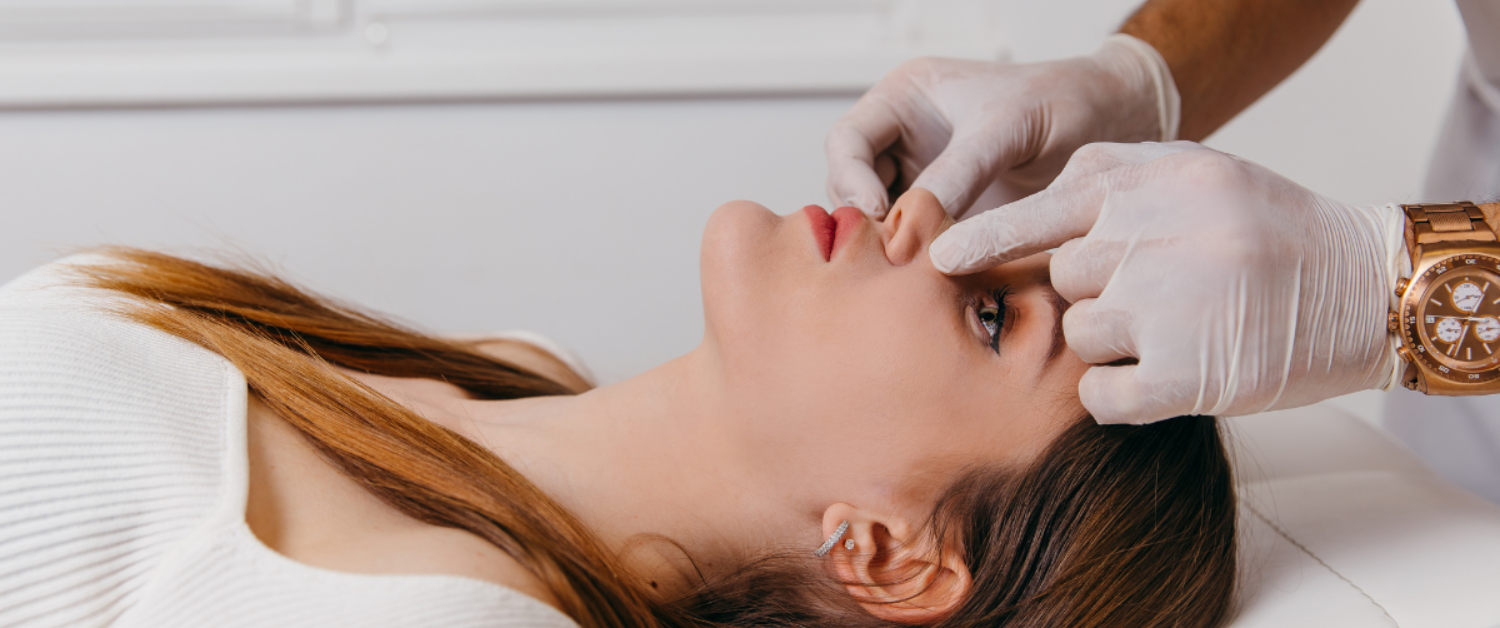Broken Nose/Nasal Fracture
At MouradMD, we specialize in treating broken noses and nasal fractures. Our expert surgeons address issues such as cartilage damage, nasal septum displacement, and facial injuries. Whether caused by an accident, fall, or sports injury, we provide effective treatment options, including nasal splints and reconstructive surgery, to restore normal breathing and facial aesthetics. Contact us today for personalized care and solutions.
What is a Broken Nose?
A broken nose, or nasal fracture, involves a break or crack in the nasal bones and/or cartilage. This injury can affect the nasal septum, the wall that divides the nasal passages, and lead to various complications like breathing difficulty, infection, and saddle nose deformity. Broken noses are common in accidents, sports injuries, and falls, requiring immediate care to prevent further damage.
The nose is made up of:
- Nasal Bones: There are two bones at the top of the nose. These bones come together to form a pyramid shape at the top 1/3rd of the nose.
- Cartilage: There are 5 cartilages that form the middle and lower thirds of the nose. These are known as the upper lateral cartilages, found in the middle third, and the lower lateral cartilages (tip cartilages) that form the tip of the nose.
Any time there is damage to any of these structures, it may be referred to as a broken nose.
Common Causes
- Accidents: Vehicle collisions, workplace mishaps, and household incidents can cause nasal fractures.
- Sports Injuries: Contact sports like football and boxing often result in broken noses.
- Falls: Slips and falls, particularly in children and the elderly, can lead to nose injuries.
- Physical Altercations: Fights or assaults can result in nasal bone fractures and other facial injuries.
Many broken noses go undiagnosed. If you have experienced trauma to your nose at any point in your life where there was a direct impact to your nose, there is a possibility that you may have broken your nose. It is crucial to disclose all nasal trauma history to your surgeon.
Signs and Symptoms
Depending on the location of the broken nose, you may notice different signs. The most common symptom would be a noticeable deformity involving the nasal bones and/or cartilages. Some nasal deformities which may be caused by a broken nose include:
- Open Roof Deformity: This refers to “splaying” of the nasal bones. The bones that form the top third of the nose should form a pyramid structure, coming together in the middle of the nose. If you break your nose in a way that makes the bones no longer come together properly, you form ridges on the top of the nose. These ridges are the edges of the nasal bones that no longer come together properly.
- Deviated Nose (Bridge): Sometimes the axis of the nose may be deviated, skewing to one side. This can refer to a fracture in the nasal bones, or nasal cartilages.
- Deviated Nose (Septum): If the nasal fracture involves the nasal septum, you may notice a nasal septum deviation in the middle portion of the nose. Deviated septum symptoms are typically mild but can include nasal obstructions, nosebleeds, and noisy breathing during sleep.
- Saddle Nose: This type of fracture refers to a break in the septum. This will result in a sagging or collapse of the middle portion of the nose, referred to as a saddling.
A broken nose typically presents with pain, swelling, and bruising around the nose and eyes. Common symptoms include:
- Nasal Pain: Intense pain around the nasal bones and cartilage.
- Swelling and Bruising: Swelling in the nasal area and bruising under the eyes.
- Breathing Difficulty: Obstruction of the nasal passages leading to difficulty breathing.
- Nosebleeds: Persistent nosebleeds or blood clot formation.
- Runny Nose: Watery fluid discharge from the nose.
- Nasal Septum Issues: Displacement or damage to the nasal septum.
How to Tell if Your Nose is Broken?
Determining if you have a broken nose involves checking for signs like pain, swelling, and deformity. Physical symptoms include:
- Visible Deformity: A misshapen or crooked nose.
- Severe Pain: Pain that intensifies with touch or movement.
- Swelling and Bruising: Significant swelling and bruising around the nasal area.
- Difficulty Breathing: Obstructed nasal passages.
- Nosebleeds: Continuous or frequent nosebleeds.
- Discharge: Watery fluid or blood from the nose.
When to Seek Medical Attention
Seek medical care if you experience severe, persistent pain that doesn’t respond to over-the-counter pain medicines, difficulty breathing through your nose, or a visible deformity like a crooked nose. Continuous nosebleeds, clear fluid discharge, and facial injuries such as vision problems or neck pain also require immediate attention. For children, prompt evaluation is crucial to avoid long-term complications. At MouradMD, our experts provide comprehensive care for nasal fractures to ensure optimal recovery.
Book a consultation with Dr. Mourad to assess your nose injury
How is a Broken Nose Treated?
Broken noses are typically corrected through surgery. The type of surgery depends on the timing of the nasal fracture and its complexity. There are two primary types of broken nose surgeries:
- Closed Reduction: his type of surgery is performed up to 7 days following the nasal fracture. Prior to the 8th day, the bones still have not fused, and can be manipulated and pushed back into place using external pressure. This can be performed in the office and under local anesthesia. This type of surgery only works with simple fractures that involve the bones. It does not address alterations to the nasal airway such as a deviated/fractured septum.
- Open Reduction/Internal Fixation: This type of surgery is performed beyond the 8 day mark after the injury has been sustained. After 8 days, the bones have already begun to heal, and in order to correct the deformity, the nasal bones need to be rebroken in a procedure known as an osteotomy. By breaking the nose in a controlled fashion, the nasal structure can be restored to its natural position.
In conjunction with open reduction, additional surgeries may be necessary to address complications from nasal trauma:
- Septoplasty: This surgery corrects a deviated nasal septum, improving nasal airflow and breathing.
- Nasal Valve Surgery: Damage or weakening of the nasal valves due to trauma can be corrected to restore proper nasal function.
Complementary Procedures
- Nasal Packing and Splints: These are used post-surgery to stabilize the nasal structures and support healing.
- Reconstructive Surgery: For severe fractures or saddle nose deformity, reconstructive surgery ensures both functional and aesthetic restoration.
At MouradMD, our expert surgeons provide personalized care and effective treatment options to ensure optimal recovery from nasal injuries.
See Before and After Patient Photos on Instagram
What is the Recovery and Follow-Up Like for Broken Nose Surgery?
Recovery and follow-up care for broken nose surgery at MouradMD are crucial for optimal healing. Post-surgery care includes managing swelling and pain, using nasal splints, and avoiding strenuous activities. Here’s a brief overview:
- Pain Management: Use prescribed pain medicines.
- Nasal Splints: Stabilize nasal passages.
- Activity Restrictions: Avoid strenuous activities and nose blowing.
- Follow-Up Appointments: Monitor healing and address complications.
- Additional Surgery: May be needed for severe fractures or deformities.
- Children’s Care: Ensure proper nasal development and function.
What Are The Risks If A Broken Nose Is Left Untreated?
If you break your nose, it is important that you have a full and thorough evaluation by a specialist. Because of the trauma associated with breaking your nose, it is not uncommon that other injuries occur at the same time, such as head/brain injuries or fractures involving the facial bones (jaw, cheeks, orbit, or skull) or eye. Other complications which may occur as a consequence of a broken nose include:
- Septal Hematoma: This refers to a collection of blood inside the nasal septum that leads to a septal perforation.
- Deviated Septum: This refers to a movement or shifting of the nasal septum.
Is Broken Nose Surgery Covered By Health Insurance?
Since breaking your nose constitutes a significant compromise to your health, it is typically covered by insurance. This becomes particularly important if the broken nose has caused a detriment to your ability to breathe that has impacted your quality of life.





